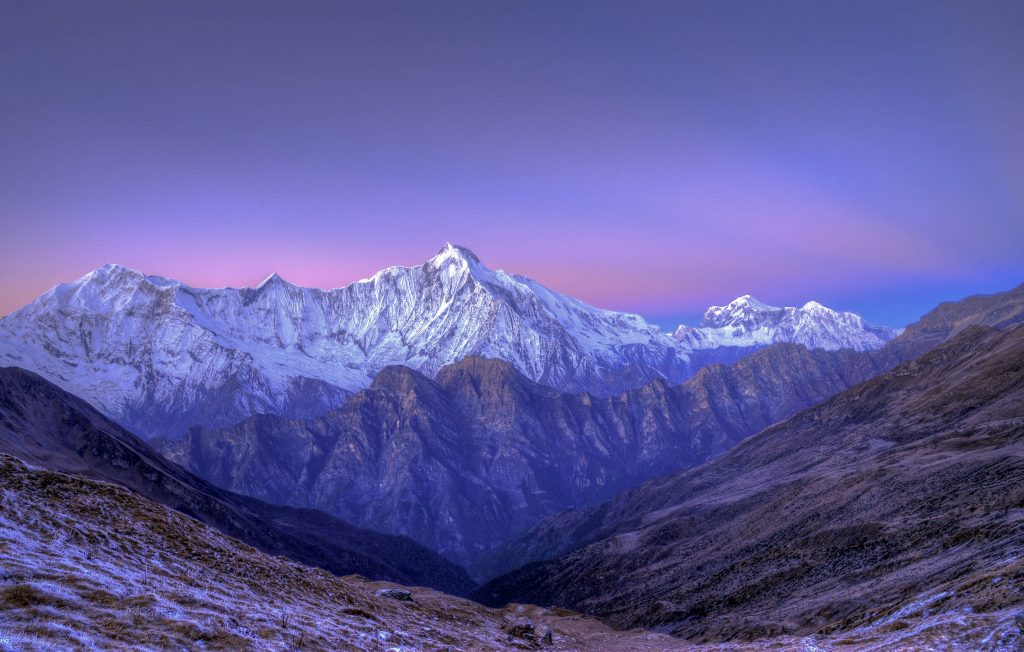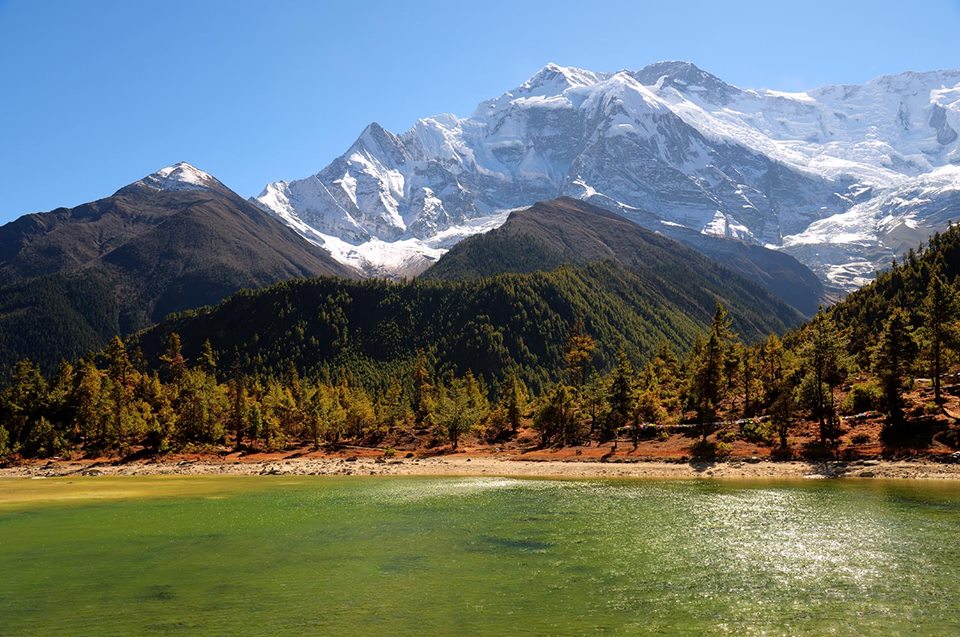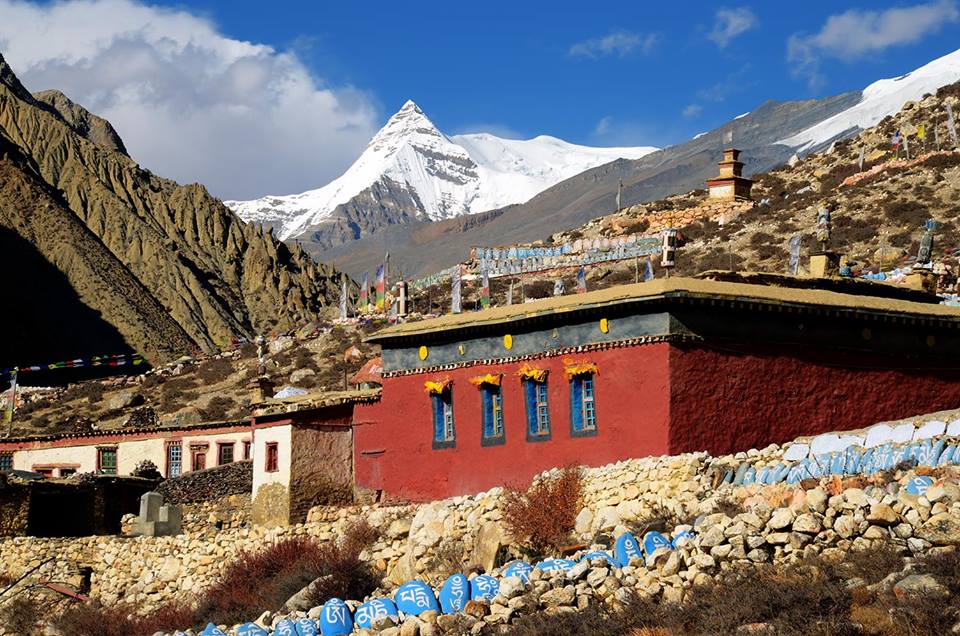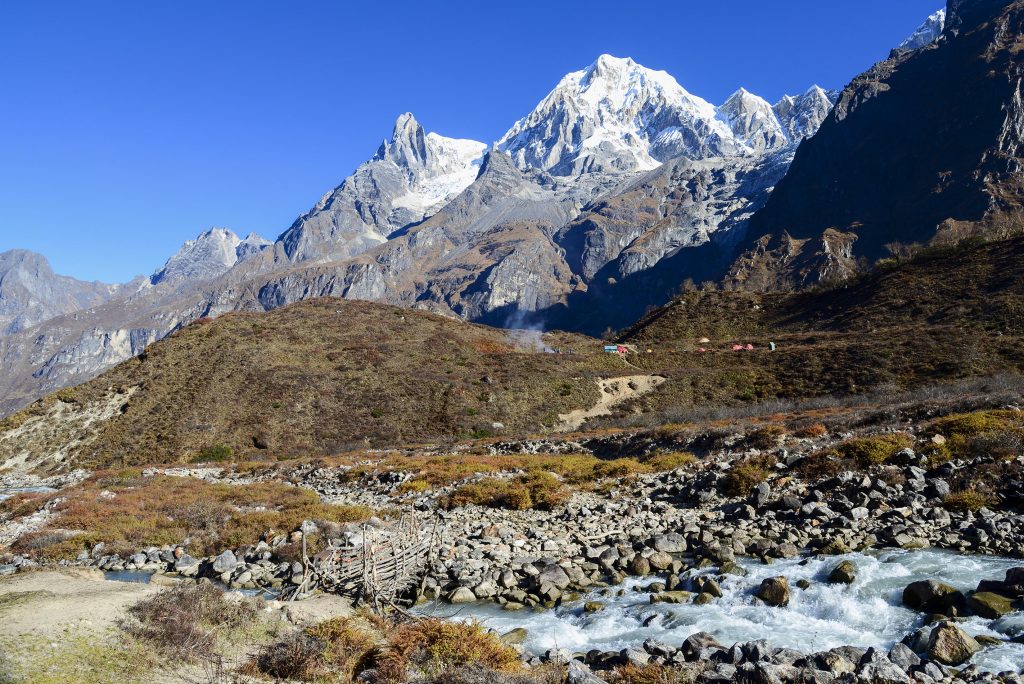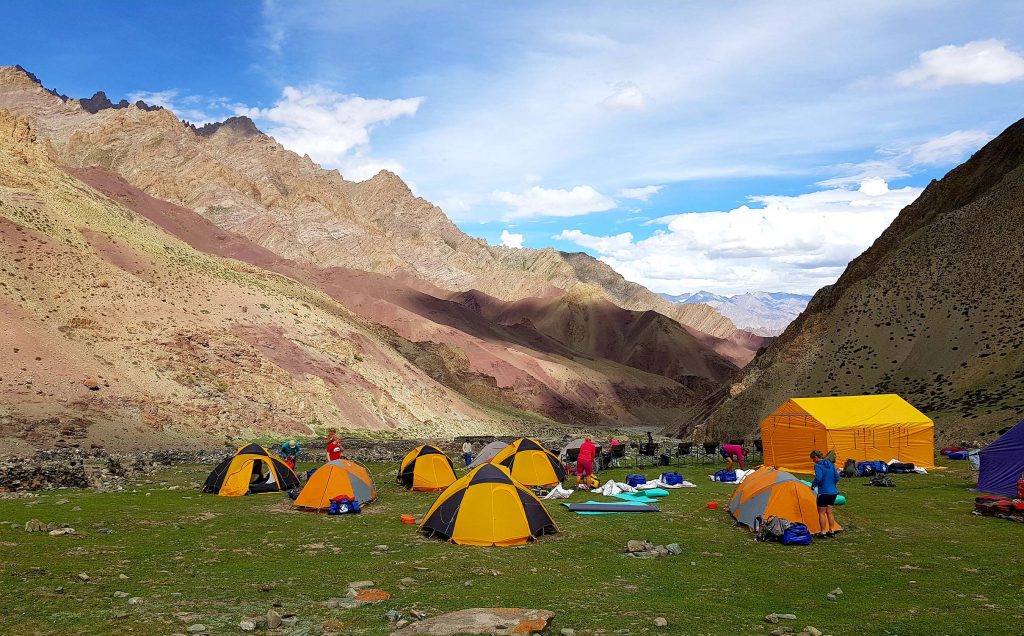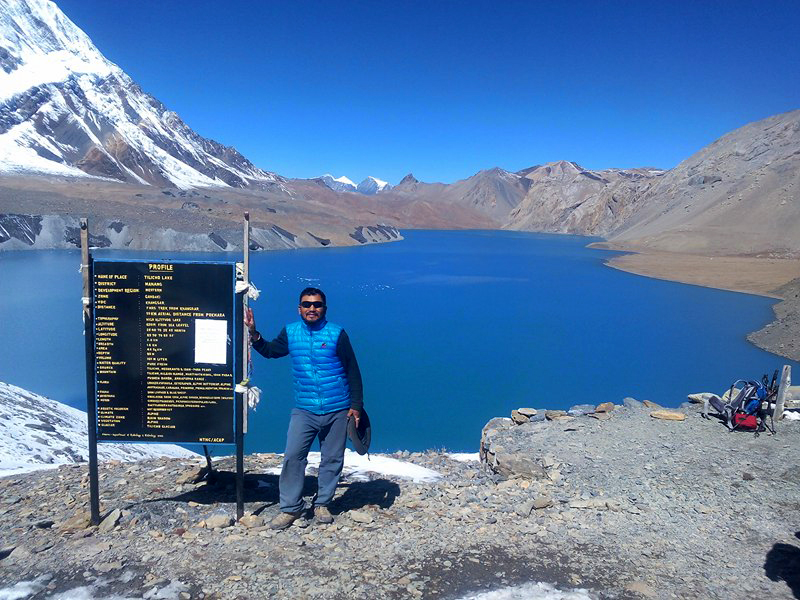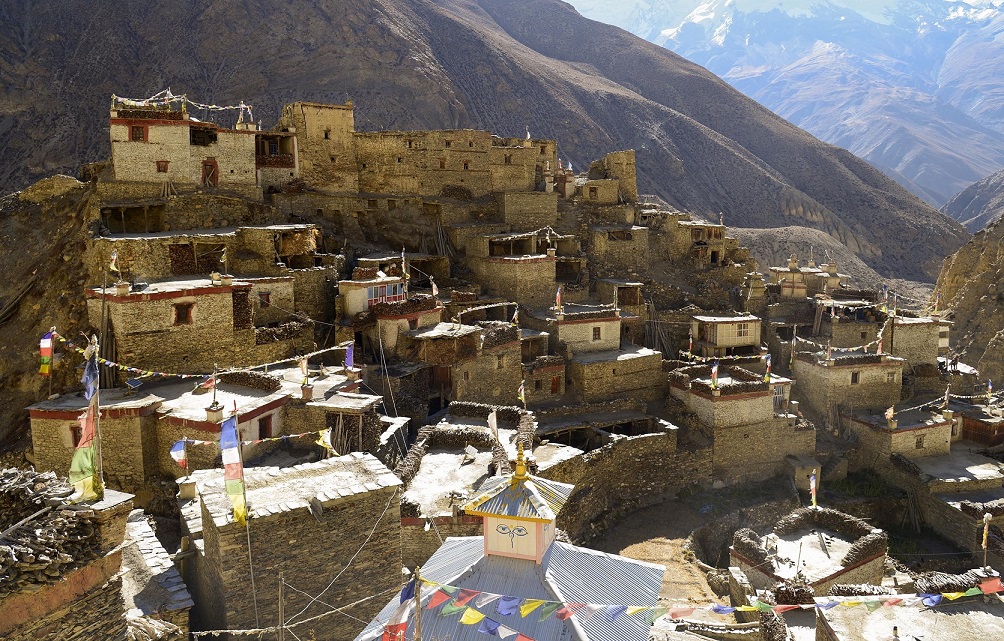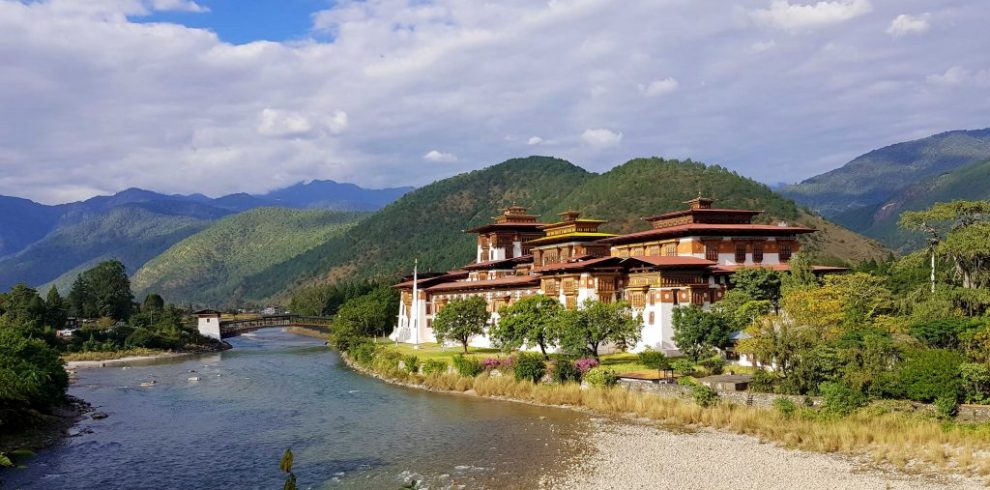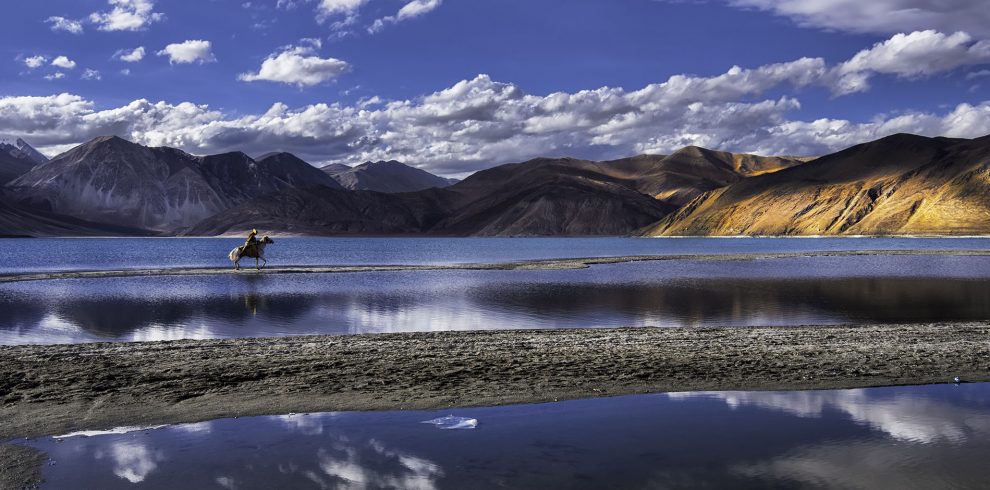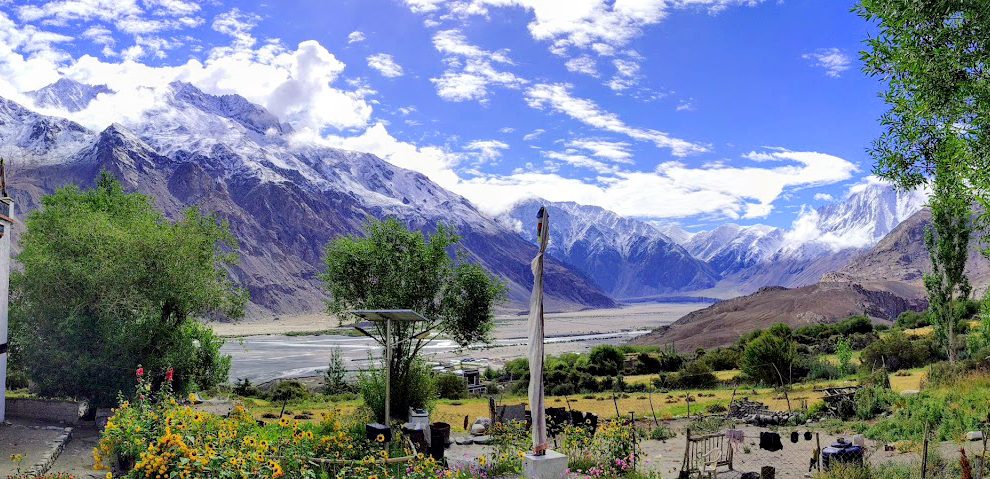This is one of the rarest and most exotic treks in the Himalaya. Although the name Annapurna suggests that it is a popular destination, make no mistake, it is one of the rarest treks in Nepal. The 7 passes on this trek takes you through some uninhabited valleys making a traverse between the western flanks of Mt. Manaslu to the Grand Barrier. We will also trek through untouched forests where there are chances to see the Red Panda, and pass through the intriguing valleys of the Nar and Phu.
Overview
Beginning with a couple of days hiking on the Annapurna circuit trail we reach Khotro, from where, we leave the main trail and trek to the hidden village of Nache. From here we will trek an off the beaten trail through dense forest to Dona Lake which is a glacial lake connected to Mt. Manaslu. From here we cross Tripple pass to connect the Manaslu Circuit trail at Thoche. Once again we leave the main trail and enter an off the beaten trek to a village called Tache. From here we enter complete wilderness and trek through forests and high altitude pastures to the base of Mt. Kang Guru. We cross two passes called Khuchumro Pass and Yarcha Pass to enter into the restricted area of Nar & Phu. The trek passes through narrow canyons and beautiful valleys of the Nar & Phu, where very few trekkers have explored. The expression “just me and the mountains” is in solidarity with the solace and serenity of this valley.
What Makes this trip Special:
- Trek across 7 exotic high altitude passes, each with amazingly beautiful mountain views of its own
- Trek and camp at the isolated and hidden Dona Lake
- Explore restricted area of the Annapurna’s Eco touristic destination
- Magnificent views of 3 of the worlds fourteen 8000m peaks- Mt. Manaslu, Mt. Dhaulagiri and Mt. Annapurna I and several surrounding dramatic mountains.
- Trek the restricted area of the Nar and Phu valley which was opened only in 2003
- Experience the time immortal cultures of the ethnically Tibetan Nomadic tribes.
- Camp at the breath takingly beautiful highest Lake in the world, Tilicho lake 4949m
- Visit ancient monasteries, ruined fortresses along the part of the Trans Himalayan trail.
- Breathtaking views from the mountain flight from Jomsom, through the world’s deepest gorge.
Itinerary
Once you reach KTM airport and finish with the immigration and custom formalities be prepared to confront the confusion outside the airport which is common in most of the south Asian countries. As you walk out of the Exit door into the passenger pick up area you will see hundreds of people with different sign boards in their hands, taxi drivers looking for fares, hotel touts looking for customers and porters trying to help with the luggage for tips. Please remain calm and do not walk out of the restricted area into the crowd straight away. Remain there and try to find the Hi On Life Adventures sign board. Once you spot it, walk straight to the signboard and identify yourself. From here we will take care of you.
When you arrive to your hotel you will be briefed about your activities and “do’s and don’ts” while your stay in Kathmandu.
In the evening we will go for a traditional Nepali dinner at Kathmandu’s finest Nepali restaurant to end the day.
After breakfast you will be taken for a half day city tour where you will be visiting some historical temples and monuments. You will end your sightseeing with a lunch.
After your lunch you will be return to your hotel and your Group leader will give you your trek briefing and issue you your ‘trek pack’ consisting of a duffle bag, down jacket, sleeping bag, inner liner for your sleeping bag and rain poncho.
Your afternoon is free for you to do your packing and purchasing your last minute items for your trek.
Drive: Approx 205 kms, 8/9 hours
Elevation of Shiri Chaur: 1100m
Early morning drive towards west from Kathmandu, following the winding road over the valley alongside the Trishuli River brings us to a small bustling highway junction called Muglin. Here we cross a suspension bridge and leave the East West Highway and continue on the Prithvi Highway that connects Kathmandu and Pokhara. After the suspension bridge over the confluence of Trishuli and Marshyangdi, we drive alongside the Marshyandi River towards Pokhara until we reach a town called Dumre which is 148 Kms from Kathmandu. On a clear day, the mighty ranges of Annapurna, Ganesh and of Manaslu are intermittently in view. Here we leave the Prithvi Highway and turn North and drive 36 kms on a narrow road to Besisahar. It will take us approx. 5 to 6 hours from Kathmandu to reach Besisahar.
Besisahar is a fairly large bustling town with plenty of tourist lodges and restaurants. This used to be the starting point of the Annapurna Circuit trek before the construction of the road. From Besisahar we need to change our vehicle to a 4 wheel drive jeep and drive alongside the Marshyangdi River on a dirt road for 32 kms to reach Shiri Chaur. It will be a tiring day with a long drive specially the rough road from Besisahar to Shiri Khola, so we take an early dinner and call it a day early.
Trek: 8 kms
Time: 5 to 6 hours
Elevation of Tal: 1700m
The trail follows the jeep road crossing the village of Jagat. Jagat used to be the tax collecting office during the Trans Himalayn Trade. It is an easy walk with not much climbs and after a 3 hour walk we reach Chyamje for lunch. After Chyamje we leave the jeep road and cross to the other side on a suspension bridge and start climbing stone stairways through a forest for about 2 hours with the river tumbling through a maze of large boulders. After reaching the top of the zig-zag climb, the valley suddenly widens out to reveal the village of Tal, which nestles amongst the fields of barley, wheat and potatoes. We have now entered the district of Manang. We stop here for the night. There is a beautiful waterfall where you can go for a bath.
Trek: 5 km
Time: 4 hours
Elevation of Nache: 2260m
The trail passes through the village and soon we cross the Marshyangdi to the other side to meet the jeep road. We continue on jeep road for an hour to reach Khotro. We will take a tea break here. After Khotro the trail climbs steeply on stone staircase for about 2 hours. To the left, you will see several waterfalls cascading down the steep, green cliffs. We will reach Nache by lunch.
Nache is a beautiful village perched on a small levelled land in between to pointed hills
Trek: 5 kms
Time: 6 hours
Elevation of Kromtong: 2975 m
The trail climbs steeply through forest to a levelled pasture, which is used for cattle. There are also potato (Alu) fields, hence the name Alubari. Today is a short walk, we will camp at Alubari. The rest of the day is free to relax or explore the area. From the camp, there are fantastic views of Annapurna II and Lamjung Himal.
Overnight Camp
Trek: 9 km
Time: 6 hours
Elevation of Kromtong: 3665 meters
From Kromtong the trail descends through a forest to Dona Khola. The river runs between two steep cliffs. Many different types of birds, Himalayan Langur, Ghoral, Himalayan Tahr and deer may be seen along the trail. There has been a few spotting of the Red Panda in this forest, but it is very rare. We follow the river along an exposed trail running high above the river to Odar. It is a cave that is used by cattle herders. We stop here for lunch. After lunch the trail becomes less exposed and runs close to the river to a Yak grazing pasture, called Dharamshala. In spring, the valley is painted red with rhododendron blooms, and yaks, cows, sheep and goats are kept here for pasture. Indeed, this is a good location to study the livelihoods of Himalayan herders. There are also a number of large caves here.
Overnight camp
Trek: 4 kms
Time: 4 hours
Elevation of Dona Lake: 4250m
There are fantastic views of Manaslu towards the East, and Annapurna II and Lamjung Himal towards the west. The meadow ahead of Dharamshala is a beautiful rhododendron and birch forest. In spring, the valley is painted red with rhododendron blooms, and yaks, cows, sheep and goats are kept here for pasture. It is a two and a half hour walk to Dona Lake. We will carry packed lunch today and at Dona Lake we will stop for lunch. After lunch we will trek back to our camp at Dharamshala.
Overnight camp
Trek: 6 km
Time: 4 hours
Elevation of Bijay Phedi: 3915m
Today’s walk is again very beautiful. The trail passes through rhododendrons forest with stunning views of Annapurna II, Lamjung Himal and Manaslu. After a couple of hours walk through the forest, we will pass Kapribai Cave. From Kapribai Cave, it is one hours to Kyudanda, where there is another large cave. We will stop here for lunch. After lunch we walk through a pasture surrounded by mountains, and continue towards a stream at Bijay phedi.
Overnight camp
Trek: 6km
Time: 8 hours
Elevation of Tripple Pass: 4480m
Elevation of Gho: 2510m
Today we begin our trek early at around 6 in the morning. Right away we begin our climb following switch backs on a fairly steep trail. After two and a half hour climb, we reach the top of the Tripple pass where we are greeted by breathtaking panorama of Annapurna II, Lamjung Himal and Kangaru Himal, with Dona Lake in the valley below. Towards the far west we can see the peaks of Anapurna III and also Tilicho peak. After spending some time at the pass, a 5 hour steep descent begins through a forest, all the way until we reach the village of Gho. The trail is not well defined and at places it is very steep making it potentially treacherous. We have to walk closely with the group during this descend. We will stop for lunch at Gho Phedi.
Overnight camp
Trek: 9 Km
Time: 5 hours
Elevation of Tachai: 2340m
Gho is a tiny stop on the Manaslu Circuit trail with some lodges. There are great views of the west face of Manaslu from Gho. A couple of hours trek following the Dudh Khola will bring us to Tilche, a Gurung and Ghale habitation, where we will stop for lunch. After lunch it is three-hour walk to Tachai. Tachai is a very picturesque agricultural village with terraced farmlands and beautiful traditional houses.
Overnight camp
Trek: 4 kms
Time: 5 hours
Elevation of Shonglai: 3360 meters
In the morning we trek towards the western end of the village passing by a water mill. We walk past some terraced farms where we can often come across Langurs. After the teraaced farms the trail climbs steeply up the tall grassy slopes and bushes. A few places demands to climb on all fours. After a couple of hours climb we will reach a ridge from where there are breath taking views of Annapurna, Lamjung and Manaslu. We will stop here for our packed lunch. The trail descends for a short distance and starts to climb through old forest with plenty of dead trees. Our camp will be in the middle of a forest.
Ovenight camping.
Trek: 8 Kms
Time: 7 hours
Elevation of Khuchumro Phedi: 4900m
The trail continues through the forest for about an hour, and soon we are in the open on an exposed steep side of the mountain. Annapurna II and Lamjung Himal soars up towards the eastern sky. From here we will climb a steep trail in between 2 giant rocks acting as a gateway. A couple of hours climb through this narrow section will bring us to the top of a ridge, where we take a lunch break. After lunch, the trek is fairly easy on gentle climb up a valley which widens up as we move closer.
Overnight camp.
Trek: 7 Kms
Time: 6 hours
Elevation of Kuchumro Pass: 4900m
Elevation of Yarcha Pass: 4860m
Elevation of Namakyu: 4445 meter
The trek begins with a gentle climb and soon we cross short steep sections until we reach the base of Kuchumro pass. From here it is a steep climb for about an hour and a half to the top of Kuchumro Pass. The views of the Annapurna range from the top of this pass are outstanding. After the pass we descend on an easy and gentle downhill and again climb on gentle gradient to cross another pass, Yarcha pass
During the monsoon season, herds of sheep, goats and yaks are brought here for grazing. There are small shelters here for the herders. This valley is also thronged by locals who come to harvest most expensive herb in the world, “Yarcha Gumba”, The Himalayan Viagra! A kilogram of this herb fetches up to 50,000 USD in the international market. Recent studies have shown that this herb helps cure dysfunctions of the lungs and kidneys. This is actually a caterpillar which is attacked by spores and kills the host and grows as a mushroom from the dead caterpillar.
Our camp at Namakyu is located at a striking location at the base of Kang Guru Himal.
Overnight camping
Trek: 12 Kms
Time: 6 hours
Elevation of Meta: 3560
The trail follows the contour along the side of the mountain which is basically the lower part of Kang Guru. It is an exceptionally scenic trek today. After about a couple of hours we reach Deurali. The trail descends a steep rough path and soon we reach a small stream. We will take lunch break here. After lunch the trail continues to descend steeply on stone staircase. Just before we reach back to treeline, we come across a dramatic section. Here the locals built a trail on an almost impossible steep side of the cliff. They have literally hammered tree logs into the wall of the mountain side and over it rocks are laid to make a path. Even though the trail looks not so promising, it is actually pretty strong as loaded yak trains walk across this trail during the Yarcha Gumba picking season. Soon we enter a beautiful forest before descending to the village of Meta.
Overnight camp
Trek: 7 Kms
Time: 4 hours
Elevation of Chyaku: 3700m
Today is an easy day which is a pleasant welcome after a few days of tiring strenuous treks that we did while crossing the high passes. From Meta , the trail meanders along the ridge passing some of the unique, colorful Tibetan Buddhist chortens that Nar and Phu are famous for. The trail is easy following the contour and is marked by spectacular shapes of very old juniper trees and colorful bushes along the sides. This day in particular is very beautiful with huge snowy peaks to the East and dramatic arid landscape to the west and north. We stop at a small Khampa settlement called Chyaku. Chyaku is a large agricultural pasture where they grow barley and potato and keep goats and sheep.
Overnight camp
Trek: 11 Kms
Time: 4 hours
Elevation of Phu: 4080m
An hour walk from Chyaku brings us to another beautiful Khampa settlement called Kyang. Beautiful views of the Annapurna II, dramatic rock cliffs and charming Khampa settlement of the sheep herders make this place amazingly picturesque. After Kyang the trail enters a narrow gorge and is cut through near vertical rock massif. After about 2 hours trek through this scenic canyons and gorges, the trail climbs steeply through dramatic rock formations to the entrance of Phu. From here, we can see the villages of Phu, the old “dzong” (Tibetan-style fortress) and the remains of two ruined forts, impressively situated atop the flatlands before the village.
Overnight camp
Phu is one of the remotest villages of the Himalayas. The history is dated back 900 years and numerous conflicts between the Tibetans and the people of Phu has been recorded. A 3 day trek from this village takes you to the Tibetan border. From here you can also enter the Kingdom of Mustang via Saribung pass.
Today we spend an acclimatization day in Phu. We will explore the tiny alleyways of the town where the villagers are seen spinning their yak and sheep wool, women weaving carpets from yak wool, pounding mustard seeds into a paste for oil, or go about their other daily chores. We will climb up to the top of the village for breath-taking views of Mt. Kang Guru and Himlung Himal. In the afternoon we will visit the Tashi Lakhang Monastery.
Overnight camp
Trek: 8 kms
Time: 7 Hours
Lunch: Pul pari
Elevation of Phu pass: 5050m
Elevation of Loang: 4680m
Once again we venture into the wilderness. The trails leads into a territory that is familiar only to the local yak herders who spend a few months here during the summer for Yak herding. The trail climbs steadily from Phu all the way to the top of the pass. It takes roughly 4 hours to reach the top of the pass. From the pass we descend to a small river where we can stop for lunch. After lunch we climb on a gentle gradient to a Yak pasture where we will camp for the night.
Overnight camp.
Trek 14 Kms
Time: 9 hours
Elevation of Nar Pass: 5400m
Elevation of Nar: 4110m
The trail is gentle in the beginning and soon we start to climb steadily on loose gravel making the climb tougher. A steady 4 hours climb will bring us to the top of the pass. The views are rewarding with a 360-degree panorama of Lamjung, Annapurna II, III and IV and as far as Tilicho Peak to the south, and Himlung, Nemjung and Kang Guru Himal to the east. After a pass we descend steeply again on loose gravel trail for a couple of hours until we reach Labse Khola, over which there is a long metal bridge. From here a gentle uphill for about an hour and a half will bring us to Nar.
Overnight camp.
Trek: 4 Kms
Time: 2 hours
Elevation of Kangla Phedi: 4630m
Nar is a beautiful village with all the houses are interconnected, just as in Phu. As we walk past the village and look back, the village of Nar looks beautiful settled on a levelled terraced farm with Kang Guru as a backdrop. The walk is easy and on gentle gradient. A couple of hour walk will bring us to Kang La Phedi, wher there are two tea shops.
Overnight camp.
Trek: 15 Kms
Time: 9 hours
Elevation of Kang La pass: 5320m
Elevation of Ngawal: 3675m
Today is a long day, so get up before sunrise and head towards the Kang La pass. The trail climbs gradually and not too steep in the beginning towards the pass. Before reaching the pass we climb steeply on switchback trail until we reach the top of the pass. From the pass there are fantastic views over Annapurna II, Gangapurna,and Tilicho Peak all above 7000m. The trail down starts off steep on a loose scree for about an hour. Then it gradually becomes less steep and we reach a beautiful meadow with views of the Chulu range. Here we stop for a picnic lunch and give rest to our tired legs after the steep downhill. There are beautiful rock formations along the trail and pass by Milerepa caves before we reach Ngawal, on the upper Pisang route of the Annapurna Circuit. Milerepas are Bhuddist are yogis and poets who renounce the world and live in caves for meditating and writing poems that inflicts the deeper meanings of life. We arrive Ngawal in the late afternoon and stay at a relatively modern and beautiful lodge with wifi, hot showers and comfortable beds and delicious food. It is a nice lodge to relax after a hard days walk.
Overnight camp.
Trek to Dhikur Pokhari: 8 Kms
Time: 4 hours
Drive: 48 kms, 3 ½ hours
Today is a very scenic walk along the side of the valley towards Upper Pisang. Breath taking views of the Annapurna II and III dominates the skyline towards the south. Upper Pisang is a beautiful traditional village with a beehive cluster type houses, closely related to Tibetan architecture. After a 3 hour walk sometimes through forest and sometimes in the open, we reach Upper Pisang where we stop here for lunch. After lunch we continue our walk to Dhikur Pokhari.
After lunch we will drive to Shiri Chaur in a jeep passing by the villages of Kota, Bagarchhap and Tal that we had walked through before entering the Nar Phu valley. At Shiri Chaur, you can celebrate your last night party of the trek because the next day you drive directly to Kathmandu and there won’t be a chance to say farewell to your staff.
Overnight camp
A tiny lake near Dhikkur Pokhari
Drive: 205 Kms
Time: 8 hours
From Shirichaur, we will take the same jeep to Besisahar, which take us about 2 hours. On reaching Besisahar, we will change from our jeep to our van and continue our drive to Kathmandu.
We arrive out hotel in the late afternoon. The evening is spent either with a farewell dinner of just take an early night after a tiring drive, and get ready for the final departure the next day.
Your Group leader will meet you at the hotel 3 hours prior to your flight time and drive you to Tribhuvan International airport for your departure.
Price Includes
- All internal transportation, in private vehicle.
- Services of English or/and Swedish speaking guide.
- Porter’s and sherpa’s assistance.
- 3 nights at Hotel Manaslu on bed and breakfast basis while in Kathmandu.
- Welcome dinner.
- 1 night at Hotel Barahi while in Pokhara.
- Half day guided Kathmandu Valley sightseeing tour with all entrance fees and lunch.
- Drive Kathmandu/ Besisahar/ Chyamje in private vehicle
- Drive Pokhara/ Kathmandu in private vehicle
- Flight Jomsom to Kathmandu
- Use of a personal trek pack consisting of a duffle bag, down jacket and sleeping bag with a fleece inner-liner
- All meals while on trek and Pokhara
- Afternoon tea/coffee service on arrival at the lodge
- Cook and kitchen helpers
- Porters for carrying bags and camping gears
- Comfortable North face VE 25 tents on twin share basis unless single supplement is booked
- 1 ridge mattress + 1 Exped Down mattress for each person.
- Kitchen tent, Dining tent and Toilet tents
- Table Chairs and all Kitchen materials.
- All three times meals during trek. (Picnic at lunch time)
- Hot beverages with biscuits and snacks on arrival to cam
- Restricted Area permit for Nar Phu Valley
- Annapurna Area conservation fee
- Trekkers Information Management fee
- Staff insurance, tourist service fee and all taxes applicable as per state law.
Price Excludes
- Personal accident and rescue insurance. You must provide your own rescue insurance
- Mineral water, beer, soft drinks and extra tea/coffee outside of normal meal times.
- Private room accommodation in Kathmandu unless a single supplement is paid.
- Optional tips to guides and porters.
- Visa costs.
- Helicopter evacuation in the unlikely situation, although we do arrange for it and make the necessary documents so that you can claim from your insurance.
Nar Phu Valley Trek is unarguably one of the most remote and least explored treks in Nepal. Opened only in 2003, this trek takes you to the wild, exotic and sparsely populated valleys of Nar and Phu, offering intriguing medieval Tibetan culture and customs completely undisturbed form, and dramatic mountains view.
Nepal’s most unscathed, Tibetan-influenced quarters, the restricted area of Nar Phu Valley can only be accessed with a special permit issued by an authorized trekking agency, who will also provide the obligatory guide. The permit is only valid for seven days so you must complete the trek in this time frame.
The village of Phu is a dramatically placed cluster of houses on a sandy slope of a mountain. It is an ancient Tibetan village which was later host to rebel Khampas fighting against the Chinese occupation of Tibet across the border in the 1960s.
From Phu we cross a couple of passes to connect the Annapurna Circuit main trail at Ngawal, crossing the villages of Nar in between.
Entering the Manang valley, we will immediately come across throngs of tourists which feels nice to socialize for a while, but it somehow steals the serenity of the adventure that we experienced along the Nar Phu Valley. Therefore we leave the highway at Manang and enter an even more fascinating valley leading to the Grand Barrier which is a massive 7000m mountain barrier, and to the world’s highest lake, Tilicho at 4949m. Then we cross the Mesokanto la pass at 5190m, which at any given comparison of beautiful scenery, surpasses the popular Thorung la by leaps and bounds. The Mesokanto la offers breath taking views of Tilicho Lake and soaring peaks of Annapurna II, III and Ganga Purna, Mt Manaslu range and the Chulus. Crossing the Mesokanto La, we leave the Manang valley and enter into another exotic valley of Mustang to end this fascinating dream trip with a mountain flight from Jomsom to Pokhara.
Itinerary B: 30 days with extended itinerary across Tilicho Lake and Mesokanto La
Day 1: Arrive Kathmandu – 1330m – welcome dinner.
Day 2. Half day city tour, lunch and trek briefing.
Day 3: Drive to Shiri Chaur – 1100m, 205 kms, 8/9 hours
Day 4: Trek to Shiri Chaur to Tal – 1700m
Day 5: Trek Tal to Nache – 2260m
Day 6: Trek Nache to Kromtong – 2975 m
Day 7: Trek Kromtong to Dharamshala – 3665 meters
Day 8: Trek Dharamshala to Dona Lake – 4250m (Acclimatization Day)
Day 9: Trek Dharamshala to Bijay phedi – 3915m
Day 10: Trek Bijay phedi to Gho- 2510m – across Tripple Pass- 4480m
Day 11: Trek Gho to Tachai – 2340m
Day 12: Trek Tachai to Shonglai – 3360 meters
Day 13: Trek Shonglai to Kujumru phedi – 4900m
Day 14: Trek Kuchumru phedi to Namakyu- 4445 meter, across Kuchumro pass – 4900m and Yarcha Pass -4860m
Day 15: Trek Namakyu to Meta -3560
Day 16: Trek to Chyaku – 3700m
Day 17: Trek to Phu – 4080m
Day 18: Rest and acclimatization at Phu
Day 19: Trek Phu to Loang -4680m across Phu pass – 5050m
Day 20: Trek Loang to Nar -4110m, across Nar Pass – 5400m
Day 21: Trek Nar to Kangla Phedi – 4630m
Day 21: Trek to Ngawal -3675m across Kang La Pass – 5320m
Day 22: Trek to Manang – 3350 m
Day 23: Drive to Khangsar 3740m – 11 kms, 45 mins and trek to Tilicho Base Camp – 4150m
Day 24: Trek Tilicho Base Camp to Tilicho Lake – 4950 m
Day 25: Trek Tilicho lake to High Camp (Big rock) – 5000m
Day 26: Trek High Camp to Yak Kharka – 3600m across Mesokanto La – 5300 m
Day 27: Trek Yak Kharka to Jomsom – 2760m
Day 28: Fly Jomsom to Pokhara – 890m
Day 29: Drive to Kathmandu – 205 Kms – 6 hours
Day 30: Departure.
Recommended preparation:
Stamina is essential, as walking days are long. We recommend previous trekking experience, preferably at altitude. Walking or jogging 45 mins to 1 hour for at least two times a week on undulating terrain or on a tread mill with inclined angle for at least 3 months prior to departure. Cycling is recommended. Long day hikes on weekends with a daypack in variable weather conditions is also recommended.
A Day on Your Trek
Although each day is different, considering the weather, general pace of the group and length of the days walk, in general your day begins with a wake up tea at around 6 to 6:30 in the morning. You will then be provided with a bowl of warm water for washing. Then you will need to pack your duffel bag and your daypack and come to the dining tent for breakfast.
After breakfast we will hit the trail and usually walk for about 3 to 4 hours before we stop for lunch. We will give you about an hour and a half rest during lunch, which will also give enough time for the staff to have their lunch and pack. Usually after 3 to 4 hours of walking we finish the days walk by 4 PM. Tea/ Coffee and snacks will be served on arrival at the camp. Your group Leader will often organize side trips in the afternoon. Your dinner will be served around 7 PM.
High Altitude
On this trek you will be going up to 5400m, so it is very important to understand the affects of altitude. The greatest provocation is going too high too fast. Hi On Life’s itinerary has been carefully designed to minimize the effects of altitude. We ascend slowly and surely allowing enough time for safe acclimatization.
Headaches and breathlessness are common at altitude which in itself is nothing to worry about. In rare cases, this may worsen to Acute Mountain sickness (AMS), so a close watch is kept on all trekkers by the group leader who is trained to recognize the symptoms of AMS which are severe headaches, nausea, lethargy, loss of appetite serious breathlessness even at rest. If any trekkers show such signs they will be descended to relatively lower and safer altitude. The Group Leader’s decision on evacuating such person to a safe altitude is final. Do not medicate yourself without first informing your group leader. Going to altitude slowly with adequate rest and adequate intake of fluid (3 to 4 litres per day), you will most likely have no problems apart from breathlessness on hills which is completely normal as the percentage of Oxygen in the air is relatively lower to that at sea level. The most important thing is not to worry about altitude because our team is there to take care of you.
Staff
Group leader: your most important member of your staff. Our Group leaders are highly trained in all aspects of the trek, conservation, first aid specializing on altitude sickness, emergency procedures and have extensive knowledge of the natural history of the area.
Sirdar: His job is to manage and organize staff duties. He is responsible for the actual operation of the trek.
Sherpas: Their job is to lead your way and distribute equal loads to the porters.
Porters: They are responsible to transport your duffle bags and their job finishes once they reach the designated lodge. Our porters are provided with Gore-Tex suits, trekking boots, gloves, hats, socks, snow gaiters and snow goggles. Most importantly, we regulate them on a 25 Kg carrying which no other company does. Our clients can therefore feel comfortable knowing that our porters are working in a good humane condition. During the trek you can see porters carrying 60-70 kg and sometimes even more than 100 kg!!)
Weather:
Oct/Nov and March/April
On the trek at lower altitude (2500m to 3500m) during daytime the Max temp can be around 15C to 20C and the Min temp can be 0C to 5C
At higher altitude (3500m to 5000m) the daytime Max temp can be between 5C to 10C and Min temp can be between -6C to OC
Please note: when there is an overcast sky, the day time temperature can get down to -2C during day time at altitudes above 4500m. Also the wind makes a big difference in the real feel of temperature.
Dec to end of Feb
On the trek at lower altitude (2500m to 3500m) during daytime the Max temp can be around 2C to 7C and the Min temp can be – 5C to 2C
At higher altitude (3500m to 5000m) the daytime Max temp can be between -5C to 5 C and Min temp can be between -8 C to -20C
Please note: when there is an overcast sky, the day time temperature can get down to -5C during day time at altitudes above 4500m. Also the wind makes a big difference in the real feel of temperature.
This is just general information and it could vary.
Recommendations for things you should bring:
Clothing:
Head:
- Warm hat wool or synthetic that covers your ears
- Sunhat
- UV shield/ Category 2 sunglasses
- Headlamp with extra batteries
- Bandana or head scarf, also useful for dusty conditions
- 2 polypropylene or wool mix t-shirts
- 2 polypropylene or wool mix long sleeve t-shirts
- 2 long sleeve thermal underwear shirts, lightweight preferably woolen
- 1 polar fleece pullovers medium weight
- 1 polar fleece jacket, OR Primaloft/ Down light weight jacket
- Gore-Tex jacket with hood, waterproof and breathable
- For high altitude use, 1 very warm goose-down jacket with hood (we provide this)
Hands:
- 1 pair medium weight wind stopper gloves
- 1 pr. lightweight poly-liner gloves
Lower Body:
- 1 pair walking shorts
- 1 to 2 pair walking trousers for trekking
- 1 pair stretchable running trouser for evening wear at lodges
- 2 pair lightweight thermal bottoms
- 1 pair Gore-Tex trousers, wind stopper
Feet:
1 pair trekking /walking boots with good ankle support
1 pair trainers, running shoes and/or sandals for Kathmandu and in lodges;
2 pair med weight preferably wool socks
2 to 3 pair of liner socks. Polypropylene or wool
2 pair lightweight trekking socks, poly or wool
Sleeping:
We provide:
- 1 down sleeping bag (rated to – 20 Centigrade or -0 F )
- 1 polar fleece liner
Rucksack and Travel Bags:
- 1 medium rucksack (30-35 litres)
- We provide you 1 big duffle bags.
- Small padlocks for duffel kit bags.
Assesories:
- 1 small roll of repair tape, 1 sewing repair kit
- Camera
- Nylon stuff sacks for food and gear storage, large Ziplocs are useful also
- 2 Water bottles (1 litre)
- 1 small folding knife
- Books, playing cards, ipod/mp3 player, games, small musical intruments
- Adequate amount of batteries, etc.
Health and trouble free holiday
There are no compulsory vaccinations required for entering Nepal. However please consult a doctor for vaccination against Typhoid, Meningitis, polio, and hepatitis. If you have special dietary requirements or allergies, please through your agent, give us a list of what you can and can’t eat so that we can provide proper food for you.
If you are undergoing a course of prescription medicine, please ensure that you have sufficient supplies for the entire holiday. Some types of drugs including antimalarials have side effects at high altitude; therefore please consult your doctors regarding these drugs. The places you trek are mosquito free and there has been no report on malaria in Kathmandu for the past couple of decades.
Insure yourself
We highly recommend you to take a comprehensive Personal Travel Insurance before leaving home. This should cover for your loss of baggage, airline delays, sickness and accidents. And it should also cover you for Emergency Helicopter Evacuation.
Money Matters
The ideal currency to bring with you is USD.
In Kathmandu: Each meal will cost around 4 to 6 USD. Plus 10 to 20 USD for your taxis if you wish to go around the city.
On trek: You will need around 6 to 10 USD per day. This money is for your hot showers, chocolates, soft drinks and beers etc and also for small donations in the monasteries.
Tipping
Although tipping is entirely optional and personal matter the following is recommended as a guideline
In Kathmandu: for bellboys, waiters and porters 30 to 50 Nepali Rupees
On the trek: At the end of the trek it is a customary to tip the field staff.
- For Staff: 150-200 USD depending on group size. The group leader will collect the tip and then split it between the staff and put it in envelops so that the trekkers can give it to the staff during the “Farwell Ceremonies”. Your Group Leader is not included in this tip.
- For Group Leader: 30 to 50 USD per person
Some Do’s and Don’ts
Nepalese people treat visitors as special guests. Although they will never rebuke you publicly for unknowingly offending them, we must consider their culture.
While in Nepal please observe the following:
- Full or partial nudity is not accepted
- Over display of affection between men and women, especially in temples and monasteries are discouraged
- Please remove your shoes before entering monasteries and temples
- Never point the soles of your feet at a person or shrine
- Many Hindu temples are closed to non-Hindus. Please ask before entering
- Locals walk around the Mani walls and Stupas in a clockwise direction as a respect and they expect you to do the same although it is not compulsory
“TODAY IS YOUR DAY! YOUR MOUNTAIN IS WAITING, SO… GET ON YOUR WAY!”
DR. SEUSS

